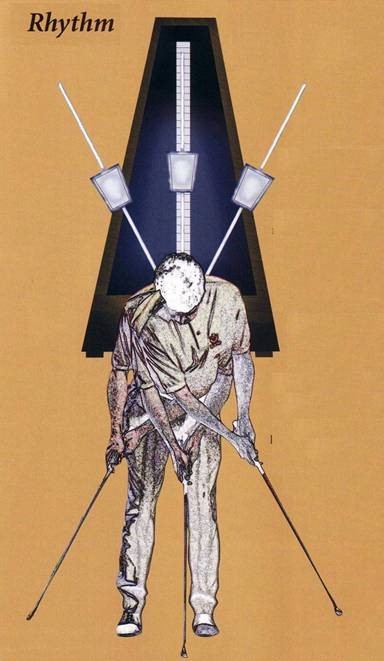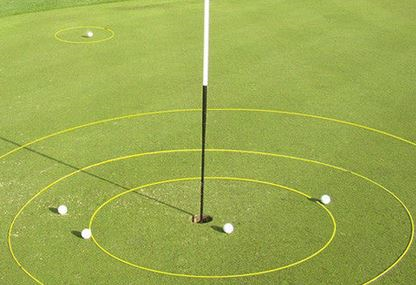3rd part of “Fundamental Putting Instruction” by SAM Academy
The Science&Motion Academy has analyzed the putting data from more than 150 Tour players with SAM PuttLab – The world’s leading putt coaching and training system. “Based on the data we collected, we have a deep understanding of the critical factors important to putting performance”, said Christian Marquardt, movement expert and founder of the Science&Motion Academy. “We want to provide golf coaches and golfers with some ideas on how to improve their coaching and training”.
This third part of “Fundamental Putting Instruction” is about the putting rhythm and putting stroke dynamics.
Frequent Errors and Consequences
Problems in distance control and problems in playing breaking putts are often related to inconsistent rhythm and timing of the stroke. The distance of the putt depends on the putter speed at impact, and the speed of the putter is a consequence of accelerating the putter at a specific level on a specific amount of path in a specific amount of time.
Well, this sounds pretty complicated, and in fact, it will be very hard to control this process consciously. Instead, skilled movements are planned in the motor cortex subconsciously, are automated, and are result of a previous motor learning process.
In many amateurs, all these different aspects change considerably between the putts.
The graphics below show the SAM PuttLab Report for Stroke Dynamics. The upper curve represents the putter speed, and forward swing at the right, and the red circle indicates impact. The curves vary considerably, in shape, in height, and in duration.
Example of problems in speed control

The lower curve represents directional acceleration, which is change of speed per time. The dotted line is pointing upwards indicating increasing acceleration to impact. The red circle at the end position indicates the differences in the stroke duration. So overall we can see a lot of variation in the movement profile.
If we compare this data to Stroke Dynamics of a Tour player, we can see differences. The curves are much more congruent, meaning that the movement is constant. The height of the curves is identical in consistency of speed and acceleration, and also the duration of the stroke is extremely consistent.
Example of significant absolute rotation, but a relative rotation very close to zero

The dotted line is a plateau indicating that the acceleration level is kept constant from downswing to impact. Overall, this stroke behavior resembles a smooth and rhythmic motion of a pendulum.
To achieve this, a good golfer simplifies the movement in some aspects: The rhythm and timing are kept constant, regardless of length of the putt and thus, the acceleration profile remains the same throughout the stroke. As a result, the speed of the putter at impact will directly depend on the length of the backstroke. By simplifying the movement like this, the speed at impact can be easily and consistently controlled.
This strategy is also used by our internal motor system to control many daily life movements, such as grasping or writing.
Ways to Improve Stroke Dynamics and Timing
 To work on constant rhythm and timing you can use a metronome, or you can count your own beat. There is no distinct number for the “optimum” timing of your stroke, it also depends on your preferences, some want to be more aggressive, and others want it more relaxed.
To work on constant rhythm and timing you can use a metronome, or you can count your own beat. There is no distinct number for the “optimum” timing of your stroke, it also depends on your preferences, some want to be more aggressive, and others want it more relaxed.
The Tour average for the forward swing is about 800 ms which would refer to 75 bpm, thus a metronome should run on about 70 to 75 bpm.
Check at what tempo the putter feels “weightless” in your hands providing the best feel of the tempo. You can also hold the putter at the lower end of the grip between two fingers and swing it to see the self-oscillation frequency of the putter to match up.
Important to understand that this timing would also match up to different distances of the putt. For short putts, you might be slightly faster, for longer putts slightly shorter, but the differences are small.
Smooth means constant forces, and the same effort in backstroke and forward stroke. This can more easily be done in the practice stroke, which then could serve as a template for the true putting stroke. In between you can check with PuttLab how your Stroke Dynamics have changed.
Now if you are able to use a more constant rhythm and timing you can work on adapting the length of the backstroke to match up to the distance of the putt. A good drill for distance control would be to put tees at distances between e.g. 6 and 12 m and then use the same rhythm and timing to get the ball as close as possible to the tees.
Distance Drill with target circles:

We hope you enjoyed this content, please stay tuned for the next part of our “Fundamental Putting Instruction” coming in a couple of weeks.
Please look at this first part, introducing the “Importance of Aim in Putting and Putter Fitting”, and the second partabout “Face Rotation in Putting”.
Contact us
To receive more information on SAM PuttLab or any other SAM product, please reach out to our sales team at sales@scienceandmotion.com or visit www.scienceandmotion.com
 About Science&Motion:
About Science&Motion:
Science&Motion is recognized for its cutting-edge technology in the Golf industry, in particular, but not limited to putting. SAM PuttLab is for more than 20 years the industry standard for professional putt analysis, putt training, and putter fitting. SAM Projection is an independent and comprehensive ball tracking and projection system for sensor-free putt training, performance drills, and games, including integration of tilting platforms. SAM PuttStudio seamlessly combines both SAM PuttLab and SAM Projection into the ultimate solution for teaching and coaching putting, adding high-speed video, balance analysis, and more.
Media Contact: Jef Carr, jef.carr@scienceandmotion.com




